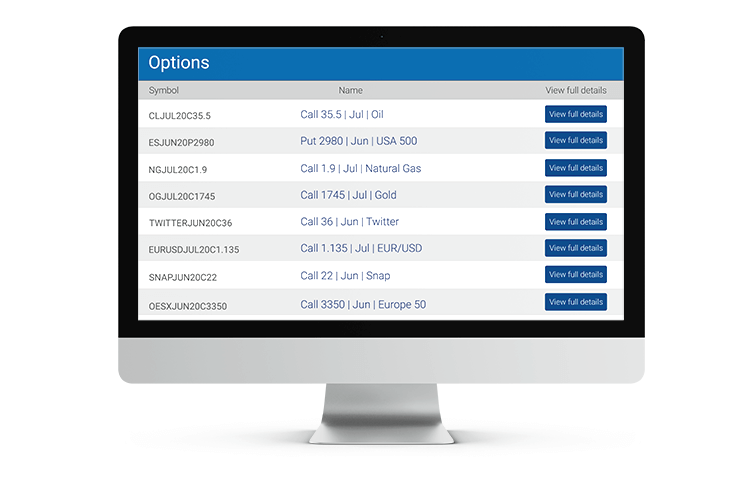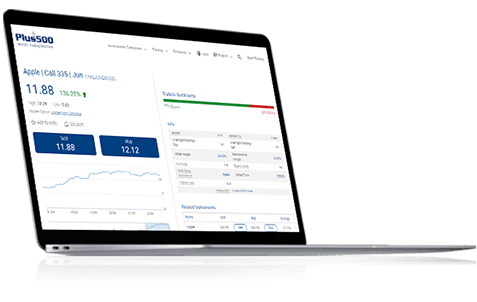What Options CFDs are Offered at Plus500?
Plus500 offers CFDs on two types of Options: Calls and Puts.
- A Call Option is usually purchased if the trader believes the underlying instrument price will increase before the contract’s expiration date. Traders can also sell Call Options if they believe that the price will drop.
- A Put Option is usually purchased if the trader believes the underlying instrument price will decrease before the contract’s expiration date.Traders can also sell Put Options if they believe that the price will rise.

Illustrative prices.
How Do Call and Put Options CFDs Work?
In the traditional market, Call Options are a type of Option contract which gives the trader (buyer) the right, but not the obligation to buy a commodity, stock, index or other asset (these are called the underlying instrument). Call Option contracts have a predetermined price (Strike Price) and an expiration date. When the underlying instrument increases in price, the trader who purchases a Call Option usually profits. Call Options CFDs take the same components as traditional Call Options, however, there is no commission on the Plus500 platform and the Call CFD buyer is not entitled to ownership of the underlying asset.
In the traditional market, a Put Option’s contract is the opposite of a Call Option’s contract. A Put Option gives the trader (buyer) the right, but not the obligation to sell a commodity, share, stock or other asset. Put Options share the same features as Call Options, however, market movements incur different outcomes.
The Breakdown of Call and Put Options
The Strike Price: With a Call Option, a Strike is the price at which the buyer can buy the underlying instrument. With a Put Option, a Strike price is the price at which a buyer can sell the underlying instrument. With Options CFDs the trader doesn’t have the right to sell or buy the underlying.
The Call Buyer: In the traditional market, the Call buyer has the right to buy an asset at the Strike price for the contract’s duration. Usually, this includes paying a commission (at Plus500, there are no commissions). If the price of the underlying surpasses the Strike Price, the Option will have value (intrinsic value). The buyer can sell the Option for a profit or receive the assets when the contract expires. However, with Options CFDs, the trader can only close the position and incur a profit or loss from the opening and closing difference (same for Put Options).
The Put Buyer: With traditional Options, the trader has the right to sell an underlying instrument at the Strike Price until the contract ends. If the price of the underlying drops or stays below the Strike Price, the Option will have value (intrinsic value). The buyer may sell the Option for a profit or receive the assets when the contract expires.
The Call Seller: In the traditional market, the Call seller (also known as Call writer) receives the premium. The income from selling a Call Option is limited to the premium, whereas a Call buyer has much more profit potential. The Put Seller is similar to the Call Seller, however, the maximum profit potential occurs if the underlying climbs or stays above the Strike Price.
Here is an example of a CFD Call Option on Apple:

Illustrative prices.
Let’s say you buy 10 shares of Apple at $100 each, for a total value of $1000. If Apple’s price rises to $105 and you close the position, you will profit $50.
In contrast, if you buy the same $1000 worth of Apple 110 Call Option CFDs, you can buy 3000 Options at $0.325 each. Then, assuming that Apple’s share price reaches the same $105, the Option's price might rise to $0.7. If you close the position then, your profit will be $1125.
On the other hand, with the same 10 shares of Apple, if you trade on stocks and the stock declines to $95 from $100 then you will lose $50. But if you trade on Options, the Option may decline to $0.125, and given that you bought 3000 options your loss could potentially be (0.325-0.125)*3000 = $600.
This means, the trader can use the same amount of capital and incur more profits, however may equally incur greater losses.
Final Thoughts
Call and Put Options can be complex to understand, so you should conduct your own research before deciding to trade. It is important to know you can buy and sell Call Options CFDs as well as buy and sell Put Options CFDs.
